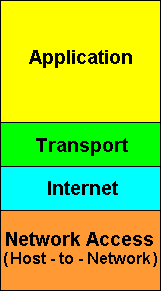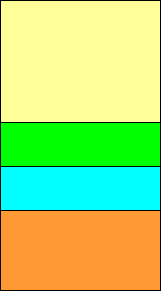7.4.3. TCP / IP protocol Stack |
TCP / IP model has set the DoD (Department of Defense) - U.S. government agency in charge of national defense, which is like an open standard was available to everyone and as such it quickly evolved to become the standard Internet protocol. TCP / IP is a set of protocols or rules developed to provide corporate computers to share resources across a network. The protocol includes a set of rules that enable communication between a host through the network. Designed in 1973rd and 1983rd became a universal 'language' of Internet. Contains and controls all aspects of communication:
Protocols prepare data on a straight basis. In transmitting it to any of the above layers toward the bottom, and vice versa in receiving. Each layer depends on the functioning of the layer below it, and in order to achieve a lower level layer uses encapsulation to accept PDU (Protocol On Unit) of higher level. Each of the layers in the OSI model has some form of packaging data - encapsulation, and the PDU is the name for the method of packaging data in the layer before the next layer leakage. Encapsulation be accepted PDU header and added a new ending, and thus making the new PDU for the next lower layer. Each PDU has a name depending on the layer in which it is created (segment, packet, frame, bits). Thus, computers communicate with each other through the layers. Upon receipt of data, while crossing the PDU from lower layer to higher subtracted some added headers and this process is called decapsulation.
ISO (International Organization for Standardization) has researched network models as DECnet, SNA, TCP / IP, NetWare and others and set the OSI (Open Systems Interconnect) model of 7 layers which helps manufacturers to make compatible networks. In the following picture shows how the TCP / IP suite of protocols processed data to send from one computer in the network to another computer in another network or the same network with the comparison with the OSI model.

|

|
||
| Figure* 7.4.6 Encapsulation of data. | |||
Software in APPLICATION layer that interprets the data and present information to people in an understandable form of protocols used to send and receive data through the Internet. If you want to send some kind of e-mail, an application designed for this purpose, will first convert it 'typed' characters into BINARY data by example 'ASCII' code. But this is not the only service that can be provided to the user, there will be, say, and WWW. In order to exchange delivers a lower layer (TCP or UDP) port number-according to which ensures that data will arrive at the destination of the appropriate service that 'knows' what to do with them. As service data coming from different sources has to know the IP address of who or where they are intended. However, some services operate using a host name and its domain (e.g. marjan.split.hr) for communication and therefore using DNS (Domain Naming System) services into IP addresses and vice versa, and the IP address will be used by the IP layer.
Thus, the passage from the highest layer to the lower layer is used SOCKET, couple PORT&IP, Ports according to IANA are divided as:
Well-known ; numbers 0 - 1023
Registered ; numbers 1024 - 49150
Private ; numbers 49151 - 65535
As the destination that is important to recognize the service in question, the destination port is always known and refers to a specific service, as defined by the IANA, and to receive feedback dynamically generated free port, were registered or private. When communication is established between computers were set up two sockets forming a single connection. Thus, the IP address refers to a specific computer and PORT guarantee data forwarding to adequate program support (software).
When data is transmitted to the lower layer, TRANSPORT layer TCP or UDP protocols break them into smaller pieces if they are too big, divide them into SEGMENTS. As there is no guarantee that it will get split data in the correct sequence numbering mechanism is used (Sequence Number - SN) which joins the segment. As all the segments that arrive need not be related to the same program support necessary port number, and it is possible to receive data for multiple applications in a period, not at the same time rather than piece by piece, but one for one application and another way for another. So in the source and the destination is determined (application) and the source (sender) port. Numbering mechanism (SN) and acknowledgment (ACK) uses TCP protocol and therefore it is said that 'reliable' while UDP does not use this mechanism certificate and belongs to the 'unreliable'. Therefore, UDP is used where the numbering of segment is no of interest. TCP adds a header that segment is shown in the following table.
| 16 | 32 | |||||||
| Source port | Destination port | |||||||
| Sequence number | ||||||||
| Acknowledgement number | ||||||||
| Offset | Resrvd | U | A | P | R | S | F | Window |
| Checksum | Urgent pointer | |||||||
| Option + Padding | ||||||||
| Data | ||||||||
| Structure of the TCP header in 32 bit lines. | ||||||||
UDP header is simpler. No control of the number of segments transmitted or received, the number of the last correctly, as well as fields for establishing communication and window boxes, indicating that this protocol is designed for rapid exchange of small data or sequence data (such as video), where the loss of a percentage of the bits is not of significance.
| 16 | 32 |
| Source port | Destination port |
| Length | Checksum |
| Data | |
| Structure of the UDP header in 32 bit lines. | |
Prepared segment comes next lower layer, INTERNET layer, using the IP protocol (routed protocol) segment adds its own header containing the IP address of the source computer and the destination IP address is read by the application. It forms a single entity called PACKET or DATAGRAM. IP packet network devices used to find the most cost effective or another possible route to a destination, using it for its 'routing' protocols. This time can be continuous if they say comes directly connected network via leased line (circuit switching) or dynamically change depending on the status of network devices and packages do not always go the same route to a destination (packet switching) and does not even have to come up with the correct sequence due to the variety of travel time. It is therefore important SN. When a network device by IP address find people who will communicate, TCP numbering at operation agreed between the source and destination of the total number of packets that can be sent before confirmation of the succession (window size). This negotiation is done dynamically, which means that if the connection is good and packages come at the proper sequence will increase the time of confirmation of receipt to say received two packs of three and four. In how many packages come 'messy' way or the 'lost' will seek confirmation or repetition for each packet which slows the delivery of information. Header that adds IP packet is shown in the following table.
| 4 | 8 | 16 | 32 | |||||
| Ver. | IHL | Type of service | Total length | |||||
| Identification | Flags | Offset | ||||||
| Time to live | Protocol | Checksum | ||||||
| Source address | ||||||||
| Destination address | ||||||||
| Option + Padding | ||||||||
| Data | ||||||||
| Structure of the IP header in 32 bit lines. | ||||||||
In addition to IP, the third layer is used, and ICMP (Internet Control Message Protocol) tightly integrated with the IP protocol, which is basically used to exchange messages during the time a network operations. ECHO supports the function that sends packets between HOST and uses this example the command PING. Was also used by viruses (very nice is not it?). More about protocols ...
|
Citing of this page: Radic, Drago. " Informatics Alphabet " Split-Croatia. {Date of access}; https://informatics.buzdo.com/file. Copyright © by Drago Radic. All rights reserved. | Disclaimer |